McDonald’s recently opened its 34,492nd restaurant, which was also its first in Vietnam. In response, The Guardian crunched some data in order to make its own McMap of the world.
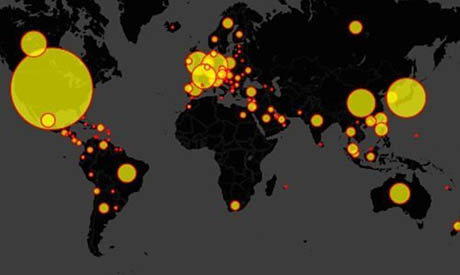
IMAGE: Number of McDonald’s by country at the end of 2012, from an interactive infographic showing expansion from 2007, built by The Guardian.
The full data set is available here for anyone who has the urge to play with it themselves. Among the insights The Guardian extracts are a small correlation between the number of McDonald’s branches in a country and its obesity rate, and the somewhat horrifying fact that there are two times as many McDonald’s as there are hospitals, per person, in the United States. (Surprisingly, America does not have the highest McDonald’s to citizen ratio; that honour is claimed by Monaco, with Andorra in second place.)
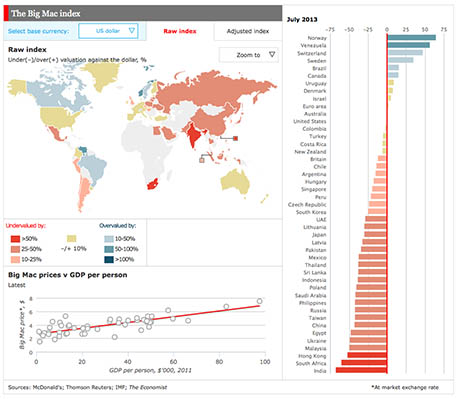
IMAGE: The 2013 Big Mac Index, adjusted for “line of best fit” between Big Mac prices and GDP per person to show currency over- or undervaluation, from an interactive infographic built by The Economist.
Just as the Big Mac Index is used as an economic diagnostic by The Economist, the geography of McDonald’s locations surely rewards spatial analysis — but perhaps at a more granular scale than The Guardian’s global atlas.
In Tom Wolfe’s A Man in Full*, a novel full of richly described places (“cataloguing rooms may yet prove to be Wolfe’s most ubiquitous talent,” wrote Norman Mailer in his review), one of the protagonists, Conrad Hensley, suggests that the Bay Area town of Pittsburg be renamed 7-Eleven:
He had driven through that whole area, from Vine Hill, where he lived, on east to Pittsburg and beyond, and it was now one vast goulash of condominiums and other new, cheap housing. The only way you could tell you were leaving one community and entering another was when the franchises started repeating and you spotted another 7-Eleven, another Wendy’s, another Costco, another Home Depot. The new landmarks were not office towers or monuments or city halls or libraries or museums but 7-Eleven stores. In giving directions, people would say, “You take the service road down past the 7-Eleven, and then…”
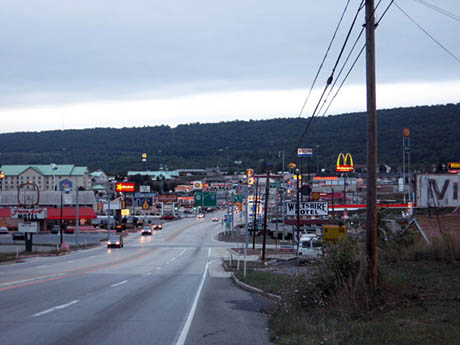
IMAGE: Breezewood, PA, is the original American franchise-scape. Photograph via Webb’s Journal.
Franchise site selection, in other words, ends up defining this new American landscape — because, of course, it also expresses it. The location of each McDonald’s is a distilled statement, a built summary of otherwise invisible forces that have been analyzed in almost incredible detail.
McDonald’s own real estate division states simply that its ideal site would be a 50,000 sq. ft. parcel of land, on a corner “with signage on two major streets,” a “signalized intersection,” and “parking to meet all applicable codes.”***
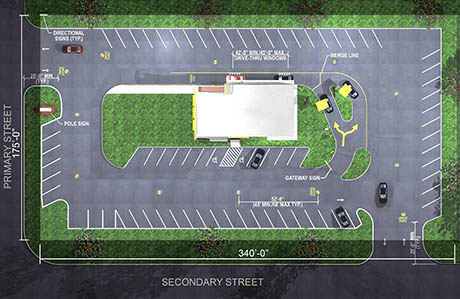
IMAGE: Typical site layout, provided by McDonald’s on their real estate page.
However, a 2001 study by Kunsoon Park (PDF), a graduate student in hospitality and tourism management at Virginia Tech, found at least 56 separate factors that went into fast-food restaurant location decisions.
These included predictable benchmarks, such as property tax levels and the age, race, and income levels of the local population, as well as more fine-grained details such as speed limits and the direction of traffic flow (e.g. “going home side versus going to work side”). Meanwhile, complex algorithms govern the optimal placement of a McDonald’s in relation to its competition, Burger King.
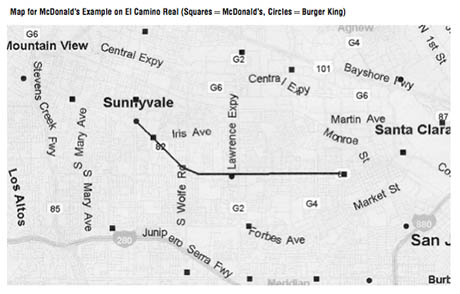
IMAGE: The optimal location for a McDonald’s along El Camino Real in Santa Clara, California, is precisely one fifth of a mile to the west of the Burger King outlet, according to UCLA professor Raphael Thomadsen in his paper, Product Positioning and Competition: The Role of Location in the Fast Food Industry.
The commercial landscape of America, and, increasingly, the rest of the world, is a reflection of this form of “location intelligence” — where each gleaming golden arch provides a shorthand guide, for those who know how to read it, to its own context.
* Which features one of the very few refrigerated warehouses to be found in fiction**, and which I am reading thanks to a recommendation from Alexis Madrigal.** Recommendations of films and novels that feature cold storage warehouses and refrigerators as central settings or characters are extremely welcome.
*** As a footnote, check out this list of McDonald’s’ “excess property” — a geography of places that no longer make the ROI grade.

